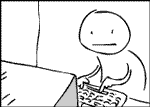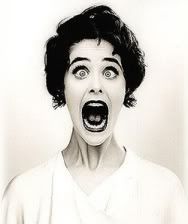 Released in November of 1982 at the height of the slasher craze, Alone in the Dark is an oddball little flick that’s Assault on Precinct 13 meets One Flew over the Cuckoo’s Nest. Written and directed by Jack Sholder (who would go on to helm 1987’s The Hidden as well as a pair of franchise sequels – the chock full o’gay subtext A Nightmare on Elm Street Part 2: Freddy’s Revenge and Wishmaster 2: Evil Never Dies), and produced by New Line founder Robert Shaye, Alone in the Dark is notable for its stunt casting, its overreliance on convenience (bolded herein for yours), and its atypical approach to the slasher formula.
Released in November of 1982 at the height of the slasher craze, Alone in the Dark is an oddball little flick that’s Assault on Precinct 13 meets One Flew over the Cuckoo’s Nest. Written and directed by Jack Sholder (who would go on to helm 1987’s The Hidden as well as a pair of franchise sequels – the chock full o’gay subtext A Nightmare on Elm Street Part 2: Freddy’s Revenge and Wishmaster 2: Evil Never Dies), and produced by New Line founder Robert Shaye, Alone in the Dark is notable for its stunt casting, its overreliance on convenience (bolded herein for yours), and its atypical approach to the slasher formula.Following a surreal, pre-title dream sequence that informs us we’re not in for the run-of-the-mill slasher du jour, the film opens on the exterior of your typical neighborhood insane asylum (only this one looks more like a quaint New England college campus, resplendent in autumnal foliage and old world architecture) where Dr. Daniel Potter (Dwight Shultz) is arriving for his first day as the facility’s new therapist. His new boss is one Dr. Leo Bain (played by Donald Pleasance, who apparently had some down time between Halloween gigs), an unorthodox, empathetic, opiate-smoking champion for the mentally deranged with a penchant for referring to patients as “voyagers” and referring to his asylum as “The Haven”.
During Potter’s first group therapy session, we’re introduced to The Haven’s crème de la crème violent cuckoo birds: paranoid Colonel Frank Hawkes (a pre-City Slickers, one-armed push-ups-at-the-Oscars Jack Palance), arsonist Byron “Preacher” Sutcliff (Martin Landau, also before his Oscar-winning career resurrection in Ed Wood), child molester Ronald “Fatty” Elster (played by the late former Olympic wrestler and opera singer Erland van Lidth), and John “Bleeder” Skagg (Phillip Clark).
Despite the unnamed state’s protestations that the facility’s most violent charges should be under maximum security lock and key, Dr. Bain explains to young Dr. Potter that “I’m running a haven here, not a jailhouse” and instead opts for a super-special, less institutional security system for his third floor loonies – no bars, all run on electricity. Yep, you can almost smell the power outage in the air. The good Dr. Potter is warned by Ray Curtis (Brent Jennings) - the world’s worst wacky-ward attendant - that his new group is “intense, man.” (He later qualifies his professional assessment by informing Potter that the inmates are “fuckin’ maniacs, man.”) Even Potter’s wife Nell (Deborah Hedwall) questions her husband’s choice of clientele:
Nell: I don’t see why you can’t just have a nice office and treat neurotics like everybody else.
Potter: Well, I guess I just prefer psychopaths. What else can I say?
Um, how about “Please don’t kill me and my family” for starters?
Dr. Potter settles into his new isolated-house-in-the-country digs with Nell and their smart-alecky daughter Lyla (Elizabeth Ward) and awaits the imminent arrival of his sister Toni (Lee Taylor-Allan), fresh from her own nervous breakdown. Meanwhile, back at The Haven, ringleader Hawkes gets it into his paranoid head that Potter has killed their well-regarded former therapist and plans to kill them, too. Plans are hatched. The next day, Preacher causes a fiery diversion in the yard, allowing Fatty to swipe Potter’s home address, conveniently left lying out on his desk. Ruh-roh, Raggy!
Before you can say “One flew over the cuckoo’s nest,” there’s a convenient blackout and The Haven’s super-special security system ends up being neither super nor special when the auxiliary generator fails. While the good doc’s sister persuades him and the missus to go hear The Sic Fucks sing “Chop Up Your Mother” at the seedy, CBGB-ish local punk club, the quirky quartet effortlessly escapes - but not before snapping Curtis in two and carjacking another doctor arriving for the late shift. They join other looters raiding a sporting goods store where they conveniently find more weaponry than on a homicidal maniac’s Christmas list. Armed with knife, axe, gun, bow-and-arrow, baseball bat, and a hockey mask for good measure (It’d be a clever nod to Friday the 13th if the franchise’s third installment hadn’t been filmed after Alone), the loony tunes gang – down to a trio after Bleeder suffers a premature slasher ejaculation when he eviscerates carjacking victim #2 with a garden hoe and runs off – is ready for action.
Cut to the following morning. While the Haven hooligans are on an early morning joyride during which the neighborhood bike messenger is run down for his hat, Potter heads for the asylum to head count the escapees and Nell and Toni decide to attend an anti-nuke rally(!). The good doctor’s wife and sister are subsequently arrested for their civil disobedience, so Potter calls in nasal-voiced Bunky - the blond, busty babysitter - to meet little Lyla when she comes home from school. Unbeknownst to any of them, little Lyla is already in the protective care of Fatty the molester and is learning paper craft with scissors.
Bunky dutifully arrives to find little Lyla asleep on her bed (Oh, the exhausting fun of paper crafts!) with Fatty nowhere in sight. Sensing an opportunity for sexy shenanigans, Bunky calls her dweeby boyfriend Billy, who quickly arrives for an afternoon booty call. (What is it about babysitting that makes teens horny, anyway?) A few bare breast nuzzlings and a false noise-in-the-closet-scare later, Billy gets ankle-grabbed and carpeted away under the bed. Bunky quivers and plays a few rounds of where-will-the-knife-slice-through-the-mattress-from-under-the-bed-next with Preacher (the proximity of knife-to-crotch at one point would give Carol Clover a field day!) before finally getting single-arm airlifted and strangled by Fatty – all the while little Lyla dreams of sugar plums in the next room.
Cut to squad cars and police activity as newly-sprung from the slammer Nell and Toni arrive home – with a fellow demonstrator named Tom in tow - to discover that Fatty and friends have been in their house. Momentary hysteria ensues and nary a word is said about poor missing Bunky before Tom and Detective Burnett (Gordon Watkins) - one of the investigating cops(!) - are invited to stay for a candlelit family dinner. (Since Alone attempted to forge its own non-traditional slasher formula and eschewed the usual group of teens-in-peril, it needed to find inventive ways to up the potential body count.)
Noises at dinner follow, and who goes to investigate? You guessed it – the African-American cop! It’s a forgivable lack of political correctness since the film predates the PC sensibilities of today and does dispatch with a Caucasian blond first. As the family (plus Tom) anxiously follows Burnett from window to window as he scopes the grounds, the hapless detective is caught in the crosshairs of a bow and arrow and promptly speared to a tree. It’s here that the film kicks into full Assault on Precinct 13 mode as the family goes into lockdown and tries to fortify the doors and windows from inside the house. Once the all-out assault begins, the film’s pacing is surprisingly good, the tension respectfully strong.
On cue, the phones go dead, Burnett’s body goes missing, and Toni goes for the valium. Potter analyzes, Tom postures for Toni’s benefit, and an unnaturally calm Lyla snarks. A lot.
Bain arrives and demonstrates that he’s more chemically imbalanced than the trio of crazies combined. When he realizes that he won’t be able to corral Hawkes and company back into their “space,” he tries to out-scripture the Preacher with talk of the Ten Commandments and how “thou shalt not kill.” But Preacher reminds him that “vengeance is his” – with an axe.
The action continues at a breakneck pace:
- Burnett’s body reappears – this time pulling a Friday the 13th/Brenda move through the window;
- Toni’s valium kicks in and she strolls off to suffer a pretty decent hallucination;
- Preacher starts a fire in the basement;
- In search of the fire extinguisher, Nell opens the wrong cupboard door and Bunky and Billy come a’ spilling out;
- Potter grapples with Preacher in the basement and puts out the fire.
“It’s not just us crazy ones who kill. We all kill, doctor, when we must. And we all die when it’s time.”
As the helpless Potter clan looks down the menacing point of Hawkes’ bow and arrow, the power conveniently snaps back on and the TV springs to life. What should just so happen to be on the screen? Why a news broadcast about the Haven escape, of course – complete with special guest commentary from the asylum’s former therapist who’s clearly not dead, just relocated to Philly! Comment remarquablement commode! Hawkes paranoid delusion meets reality and he exits, stage left. At movie’s end, Hawkes finds himself at the pseudo-CBGB's club from earlier, where he finds camaraderie with the drug and danger-fueled patrons of the punk scene.
Alone in the Dark is admirable in its attempts to set itself apart from its slasher brethren, although the film’s more cerebral brand of dark humor probably missed its mark among the blood-n-boobies crowd. From the histrionics of Hedwall and Taylor-Allan to the unabashed campiness of Palance, Landau, and Pleasance, the cast helped elevate the film to the level of highbrow horror masquerading as farce - without crossing over the imaginary line that separates satire from slasher. As credible as it is outlandish, Alone in the Dark never lost sight of its slasher mediocrity while attempting to infuse a modicum of novelty into the formula.
Useless Slasher Fact: Keep an eye out for perennial genre fave Lin Shaye (A Nightmare on Elm Street, Critters, Dead End, 2001 Maniacs, Snakes on a Plane) - sister of prolific Alone in the Dark producer Bob Shaye – in a playful, early-career cameo as a wacky receptionist!












